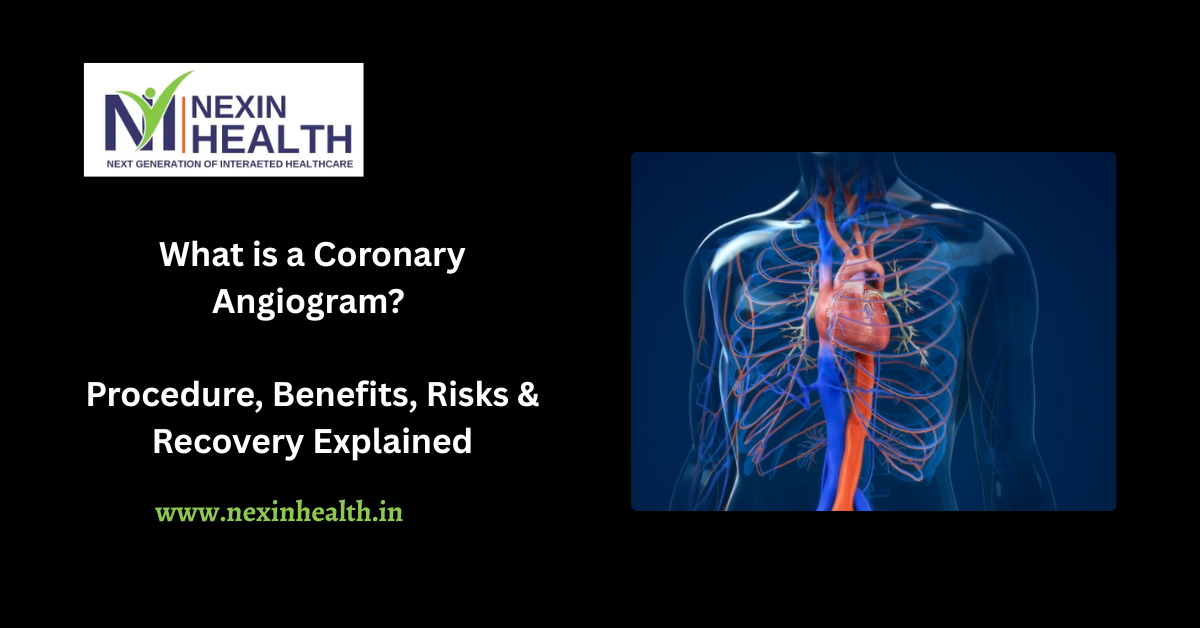What is a Coronary Angiogram? Procedure, Benefits, Risks & Recovery Explained


A coronary angiogram is a medical imaging test that helps doctors see how well your heart’s blood vessels are functioning. If you have symptoms like chest pain or shortness of breath, this test can help diagnose blocked or narrowed arteries that may lead to heart disease. In this blog, we will explore what a coronary angiogram is, how it’s done, its benefits, possible risks, and what to expect before and after the procedure.
A coronary angiogram, also called cardiac catheterization, is a special type of X-ray test used to examine the coronary arteries – the arteries that supply blood to the heart. It helps doctors identify any blockages or abnormalities in the blood vessels.
The procedure uses a contrast dye injected through a catheter, which is then visualized through X-ray imaging to check for any narrowing or blockage in the arteries.
Doctors recommend this test for several reasons:
Chest pain (angina) that could indicate reduced blood flow to the heart.
Shortness of breath without a clear cause.
Abnormal results from other heart tests like ECG or stress tests.
To assess the extent of coronary artery disease (CAD).
Before planning treatments like angioplasty or bypass surgery.
If your doctor has recommended a coronary angiogram, you’ll receive instructions to prepare for the test. These may include:
Fasting: You may need to avoid eating or drinking anything for 6–8 hours before the test.
Medications: Some medications may need to be adjusted or stopped. Inform your doctor about all the medications you take, including diabetes or blood-thinning drugs.
Allergies: Let your doctor know if you have allergies to iodine or contrast dye.
Consent form: You’ll be asked to sign a consent form acknowledging the risks and benefits of the procedure.
The procedure usually takes 30 minutes to an hour and is performed in a hospital’s cardiac catheterization lab (cath lab).
Insertion Site: A small tube (catheter) is inserted into a blood vessel in your wrist or groin.
Guiding the Catheter: Using live X-ray images, the catheter is guided through your blood vessels to your heart.
Injection of Contrast Dye: A special dye is injected into the coronary arteries.
X-ray Imaging: As the dye moves through your arteries, X-ray images are captured to detect any blockages or abnormalities.
You may feel a brief sensation of warmth or flushing when the dye is injected, but the procedure is generally painless.
After the angiogram:
You’ll be moved to a recovery area where your heart rate and blood pressure are monitored.
If the catheter was inserted in your groin, you may need to lie flat for a few hours to prevent bleeding.
If it was inserted in the wrist, recovery is generally quicker.
Most people can go home the same day, although some may need to stay overnight for observation.
Like all medical procedures, coronary angiography carries some risks, although they are rare. Possible complications include:
Bleeding or bruising at the catheter insertion site.
Allergic reaction to the contrast dye.
Heart attack or stroke (extremely rare).
Irregular heart rhythms (arrhythmias).
Infection at the puncture site.
Inform your healthcare provider immediately if you experience chest pain, swelling, or fever after the procedure.
Accurate diagnosis of coronary artery disease.
Helps in planning further treatment like angioplasty or bypass surgery.
Can sometimes allow immediate treatment if blockages are found (angioplasty and stenting).
Minimally invasive and relatively quick.
Also Read:
Recovery from a coronary angiogram is usually fast, but it’s important to:
Avoid heavy lifting or strenuous activity for a few days.
Drink plenty of water to flush the contrast dye from your system.
Monitor the puncture site for signs of bleeding or infection.
Follow your doctor’s instructions regarding medications and follow-up care.
Your doctor will also discuss the results of the angiogram with you and recommend further treatment if needed.
Seek medical help if you notice:
Redness, swelling, or discharge at the catheter site
Unusual pain or warmth at the insertion area
Fever or chills
Difficulty breathing or chest discomfort
A coronary angiogram is a crucial tool in diagnosing and treating heart conditions. While the idea of inserting a catheter into your blood vessels may sound intimidating, it’s a routine, safe, and effective procedure. With early detection of coronary artery disease, patients can receive timely treatment and significantly improve their heart health.
If you’ve been advised to undergo a coronary angiogram, understanding the process, benefits, and recovery can help you feel more confident and prepared.
Also Read:
At NexIn Health, we understand that invasive procedures are not always the first choice for every patient. That’s why we offer advanced EECP therapy as a safe, FDA-approved, and highly effective treatment for chronic heart conditions. Here’s why NexIn Health is the best choice:
Our EECP sessions are conducted under the guidance of trained cardiologists and healthcare professionals who tailor each treatment based on your heart health and medical history.
We use modern EECP systems with real-time ECG monitoring to ensure both safety and effectiveness throughout the treatment.
At NexIn Health, patient comfort is our priority. Our EECP rooms are designed to be peaceful and comfortable, ensuring a stress-free healing experience.
Many of our patients have reported significant reductions in chest pain, improved stamina, and better overall cardiac health without surgery or medication.
We offer flexible and affordable EECP treatment packages with EMI options, making heart care accessible to all.
You may benefit from EECP therapy at NexIn Health if:
You have chronic stable angina.
You’ve had previous bypass or angioplasty but symptoms persist.
You’re not a candidate for invasive procedures due to age or other health issues.
You want a non-invasive, drug-free way to improve heart function.
View this post on Instagram
A post shared by NexIn Health | Non Invasive Heart & Spine Care (@nexinhealth)
Also Read: